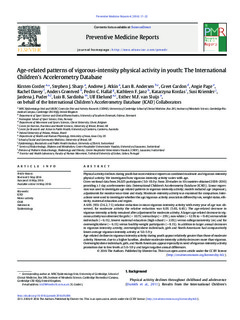Age-related patterns of vigorous-intensity physical activity in youth: The International Children's Accelerometry Database
Corder, Kirsten; Sharp, Stepher J.; Atkin, Andrew J.; Andersen, Lars Bo; Cardon, Greet; Page, Angie; Davey, Rachel; Grøntvedt, Anders; Hallal, Pedro C.; Janz, Kathleen F.; Kordas, Katarzyna; Kriemler, Susi; Puder, Jardena J.; Sardinha, Luis B.; Ekelund, Ulf; van Sluijs, Esther M. F.
Journal article, Peer reviewed
Permanent lenke
http://hdl.handle.net/11250/2429052Utgivelsesdato
2016-05-16Metadata
Vis full innførselSamlinger
- Artikler / Articles [2119]
Originalversjon
Preventive Medicine Reports. 2016, 4, 17–22 http://dx.doi.org/10.1016/j.pmedr.2016.05.006Sammendrag
Physical activity declines during youth but most evidence reports on combined moderate and vigorous-intensity physical activity. We investigated how vigorous-intensity activity varies with age. Cross-sectional data from 24,025 participants (5.0–18.0 y; from 20 studies in 10 countries obtained 2008–2010) providing ≥ 1 day accelerometer data (International Children's Accelerometry Database (ICAD)). Linear regression was used to investigate age-related patterns in vigorous-intensity activity; models included age (exposure), adjustments for monitor wear-time and study. Moderate-intensity activity was examined for comparison. Interactions were used to investigate whether the age/vigorous-activity association differed by sex, weight status, ethnicity, maternal education and region. A 6.9% (95% CI 6.2, 7.5) relative reduction in mean vigorous-intensity activity with every year of age was observed; for moderate activity the relative reduction was 6.0% (5.6%, 6.4%). The age-related decrease in vigorous-intensity activity remained after adjustment for moderate activity. A larger age-related decrease in vigorous activity was observed for girls (− 10.7%) versus boys (− 2.9%), non-white (− 12.9% to − 9.4%) versus white individuals (− 6.1%), lowest maternal education (high school (− 2.0%)) versus college/university (ns) and for overweight/obese (− 6.1%) versus healthy-weight participants (− 8.1%). In addition to larger annual decreases in vigorous-intensity activity, overweight/obese individuals, girls and North Americans had comparatively lower average vigorous-intensity activity at 5.0–5.9 y. Age-related declines in vigorous-intensity activity during youth appear relatively greater than those of moderate activity. However, due to a higher baseline, absolute moderate-intensity activity decreases more than vigorous. Overweight/obese individuals, girls, and North Americans appear especially in need of vigorous-intensity activity promotion due to low levels at 5.0–5.9 y and larger negative annual differences.
